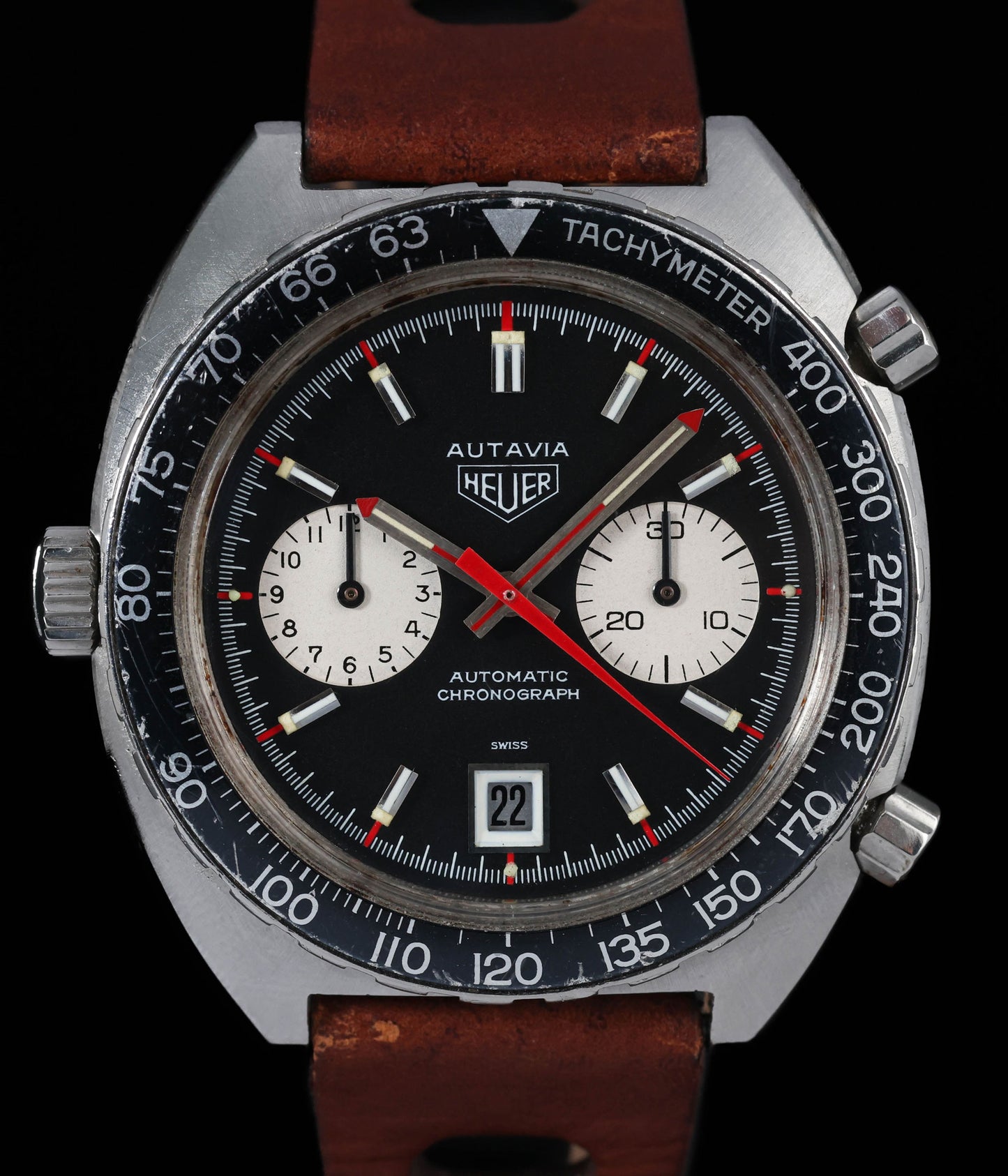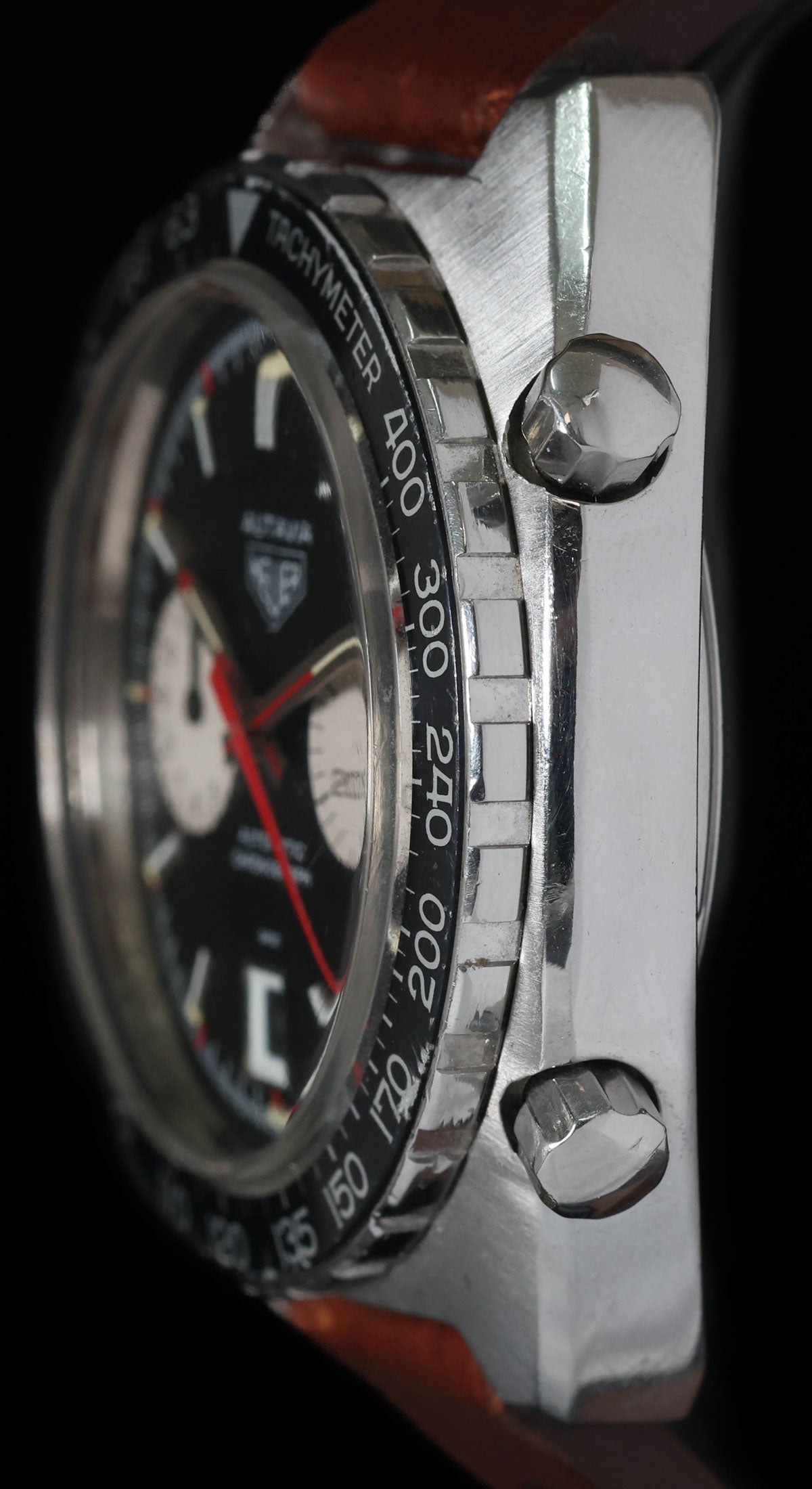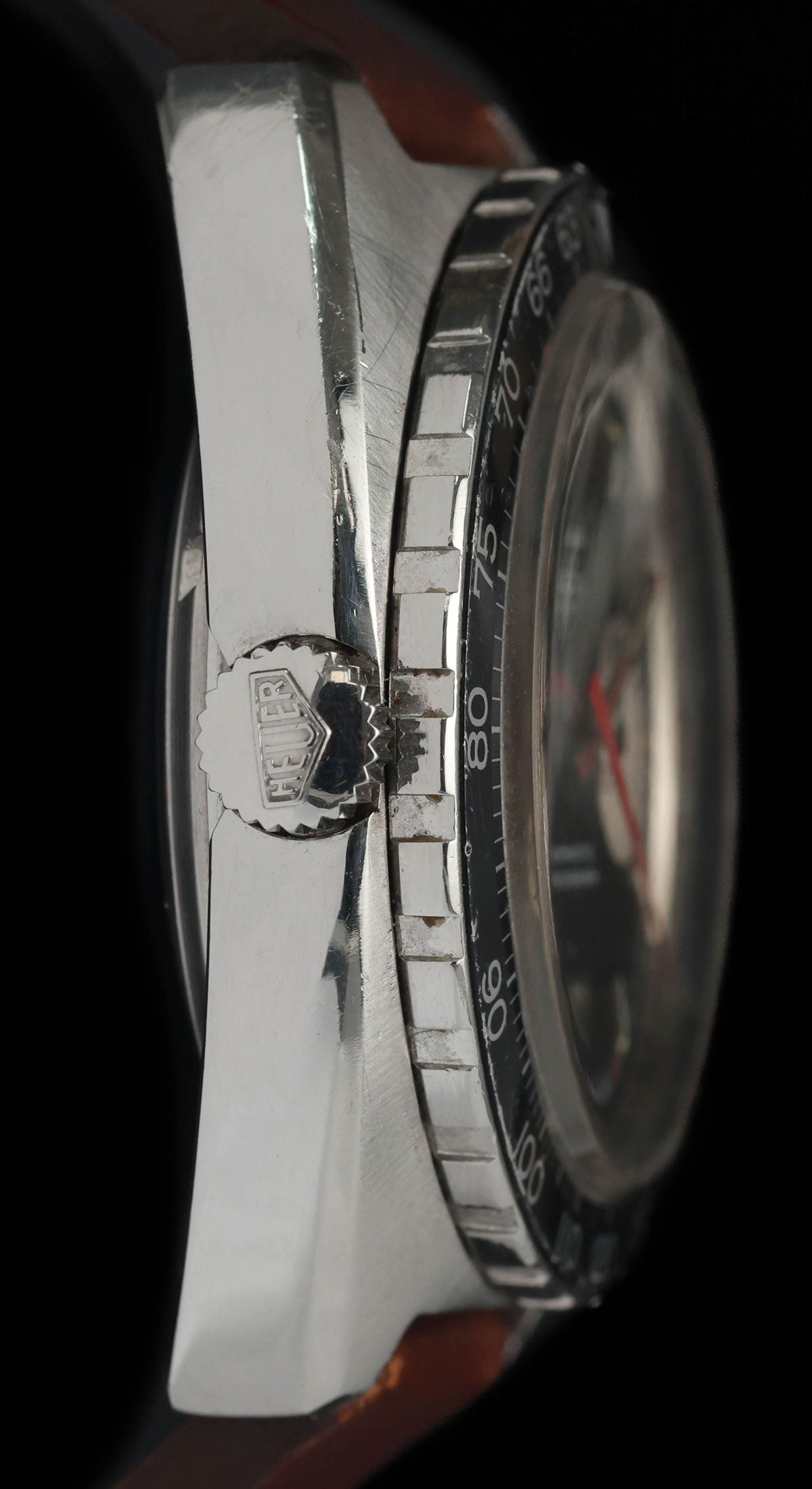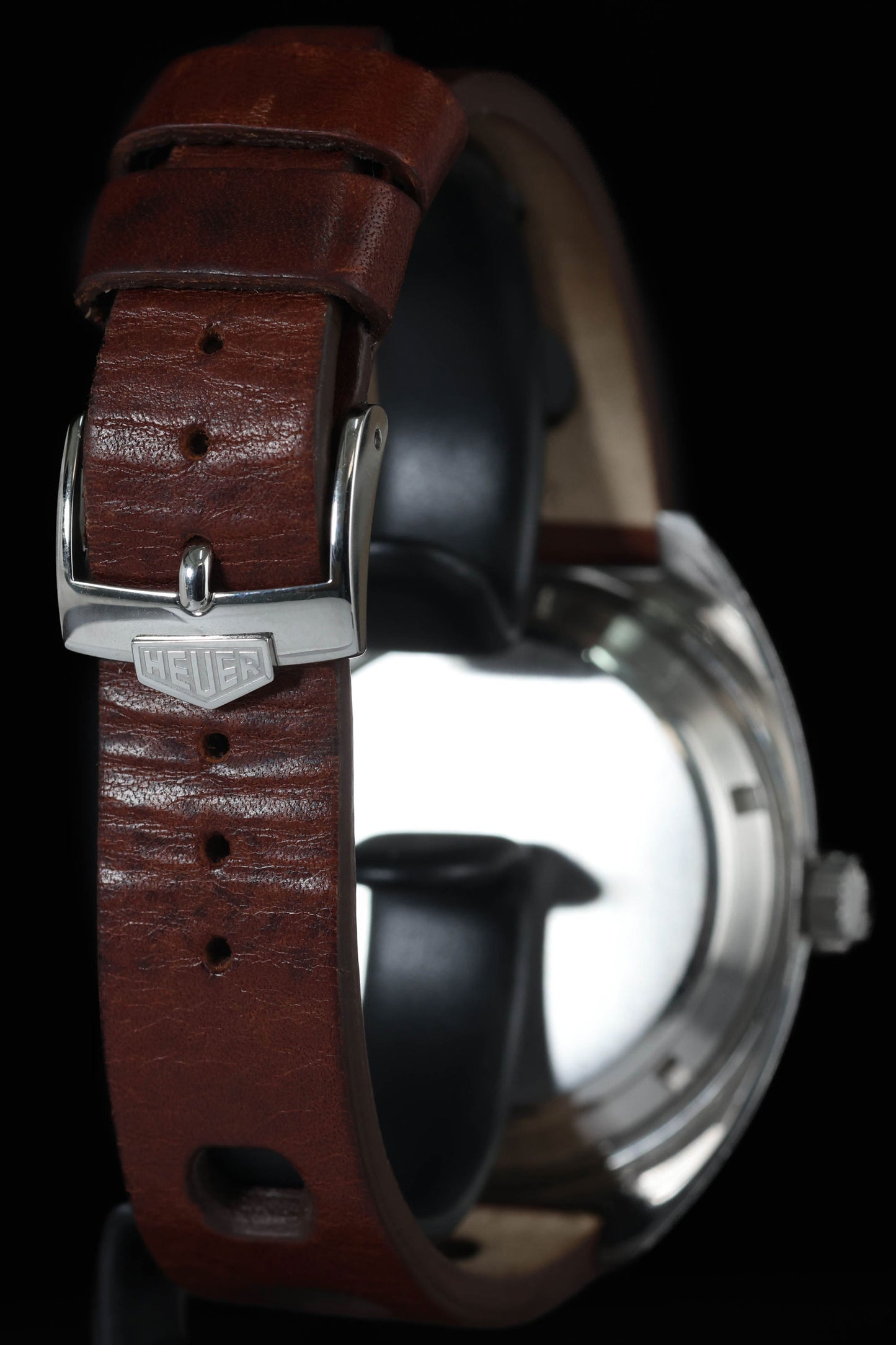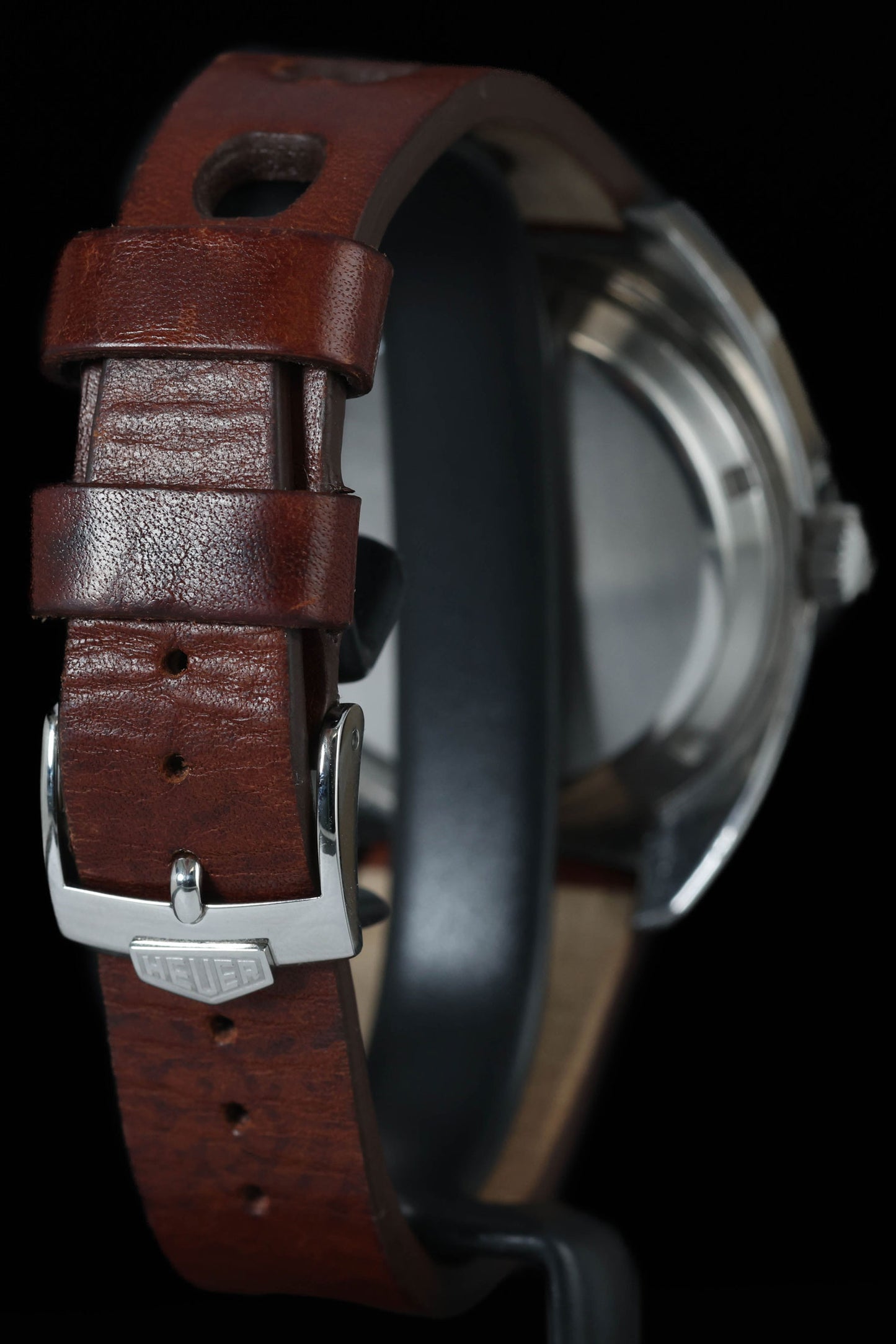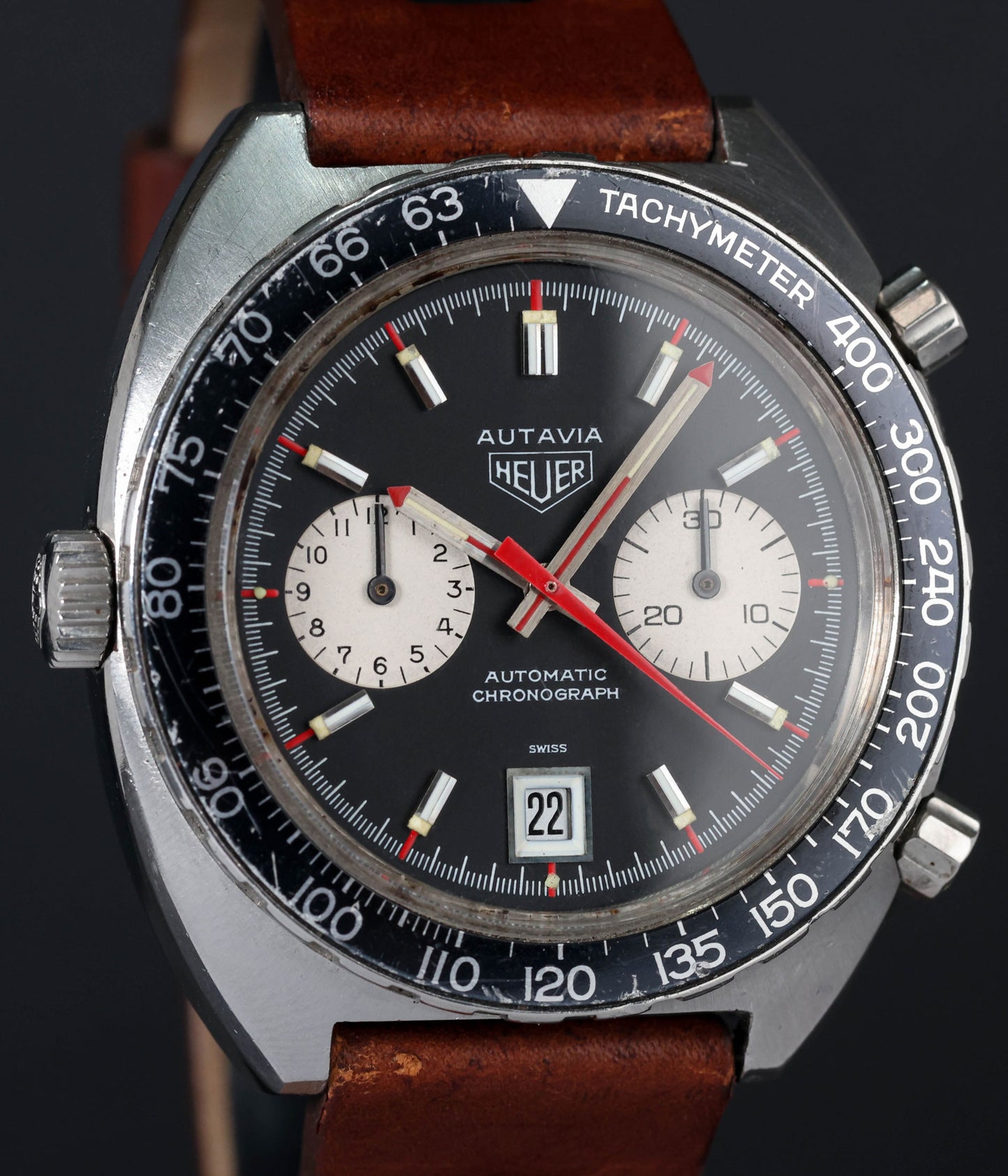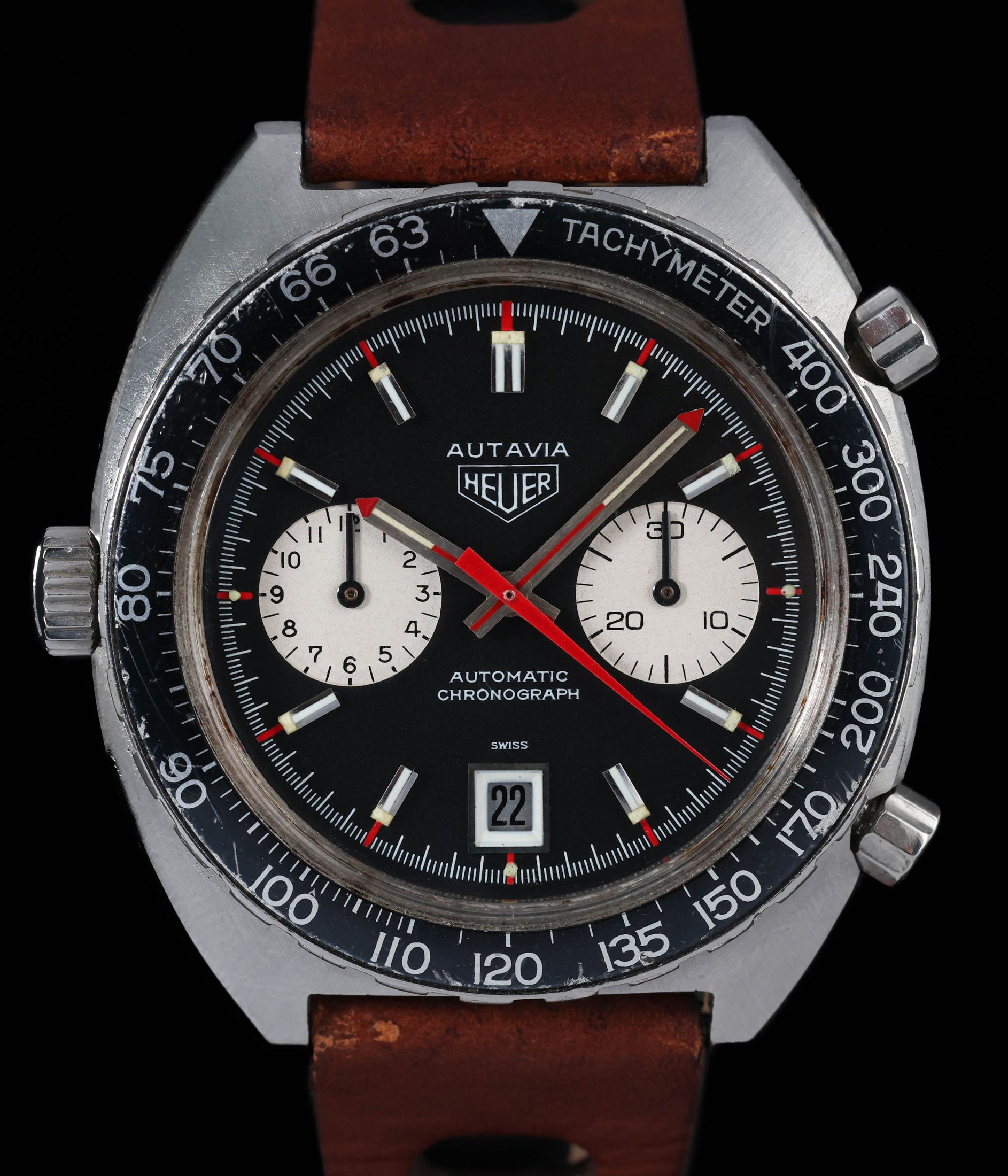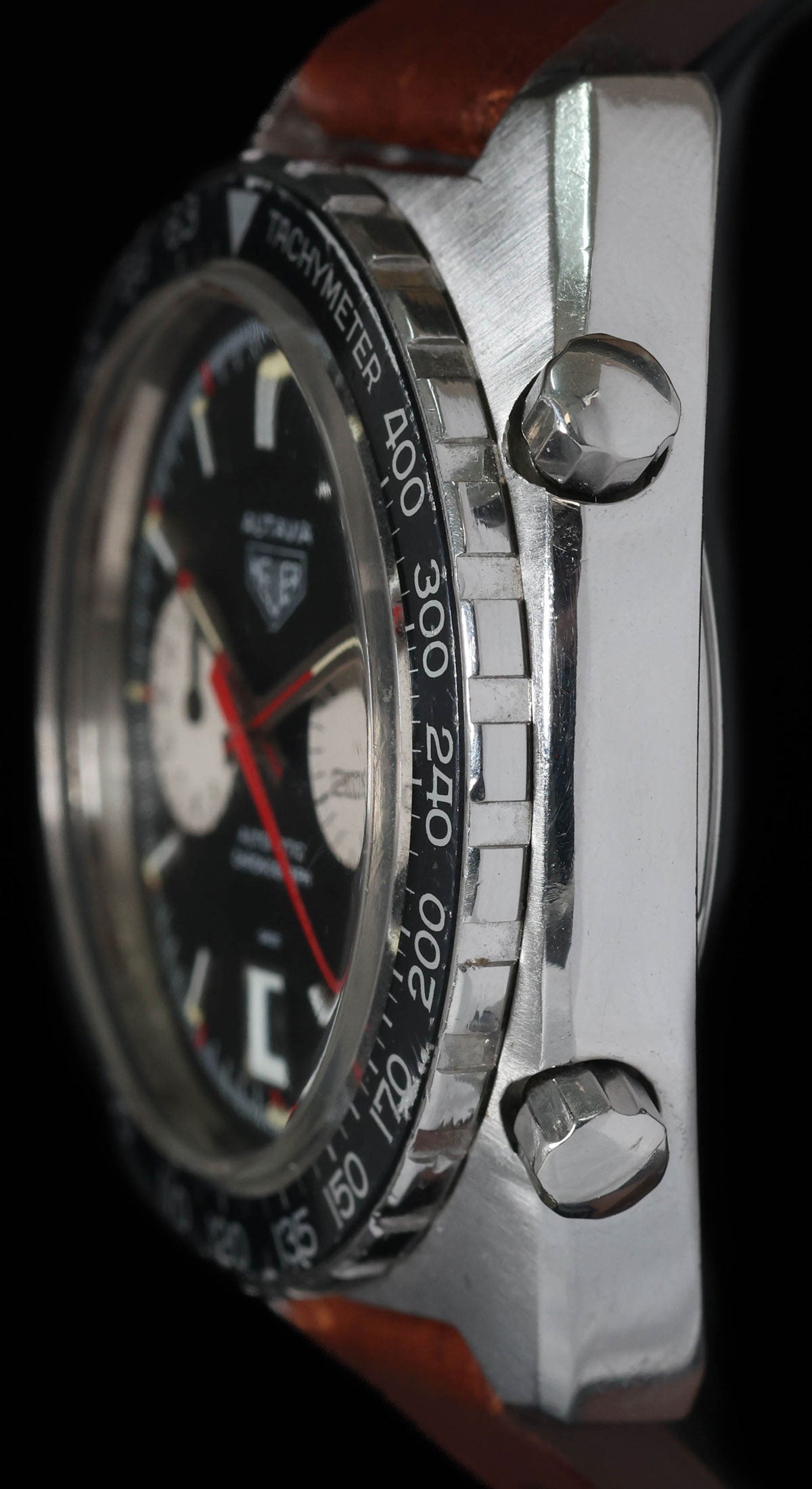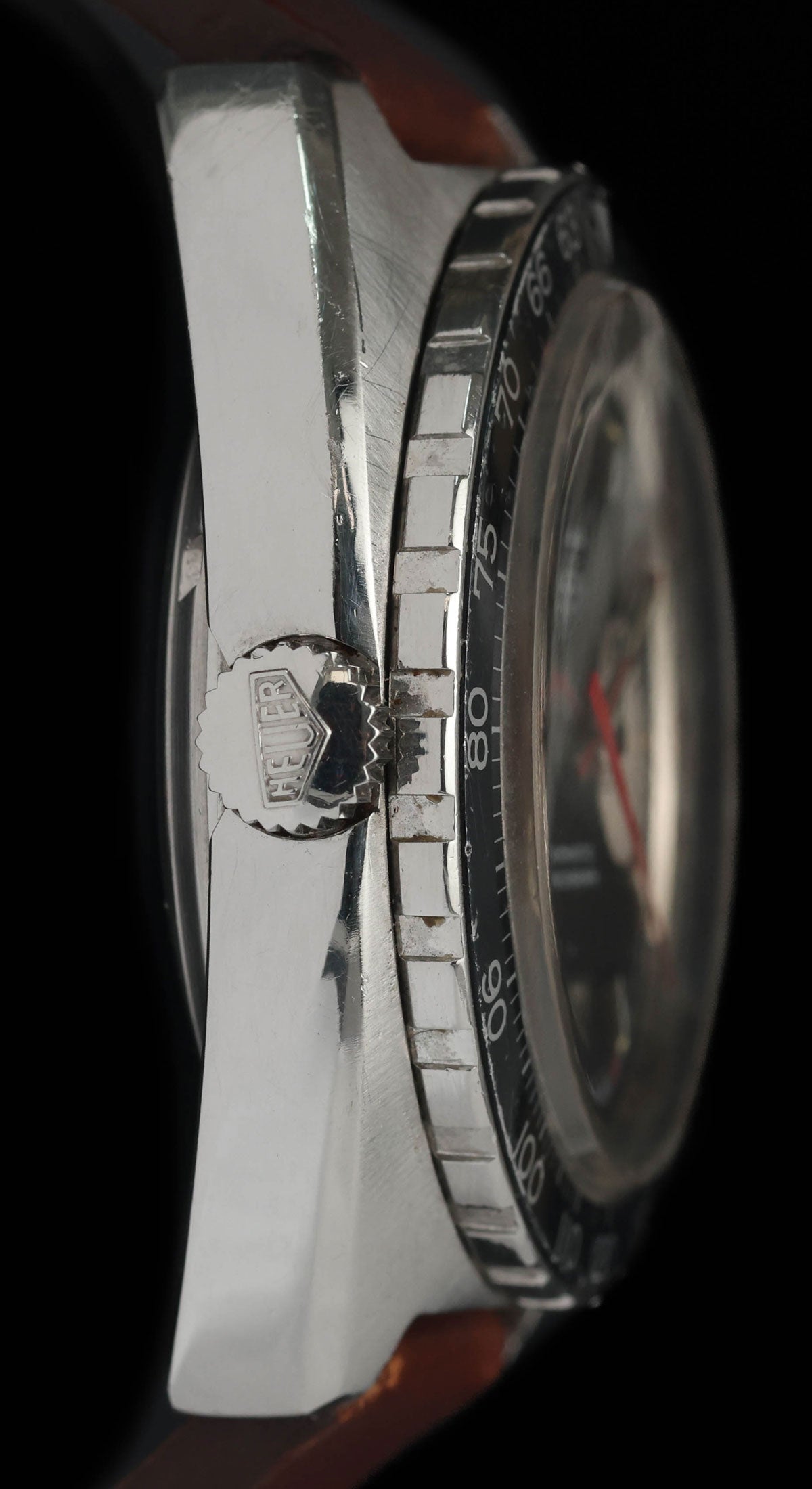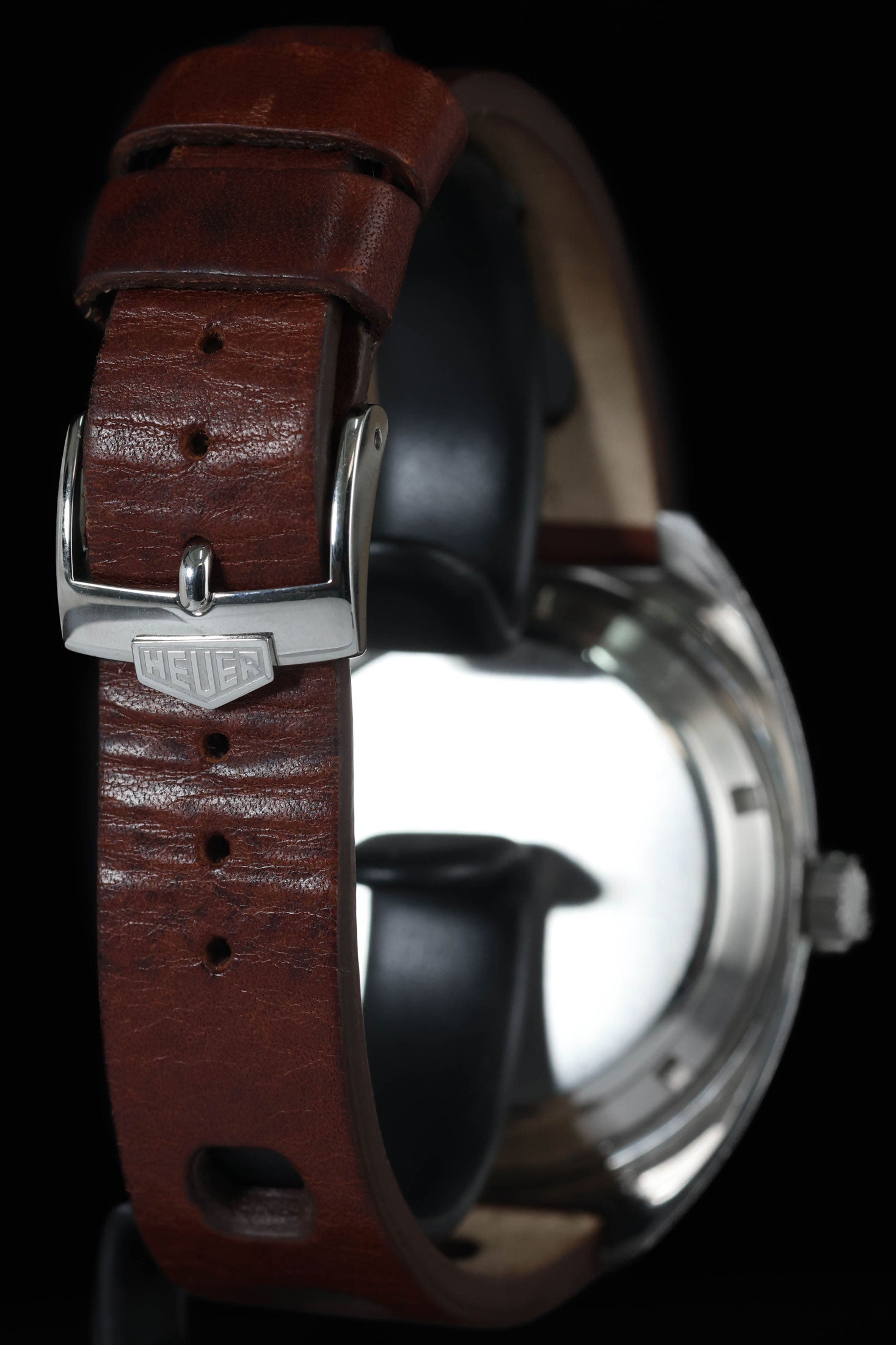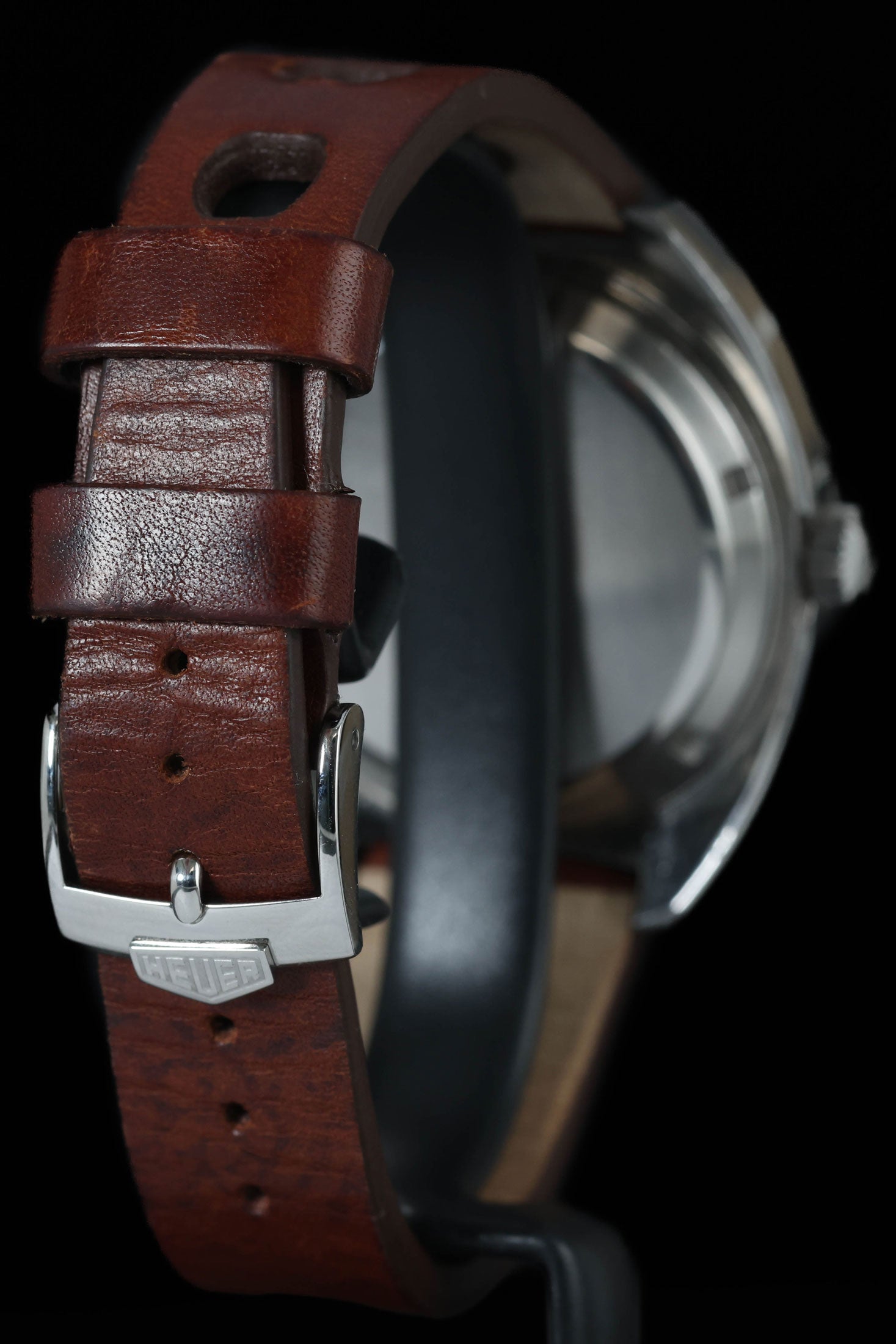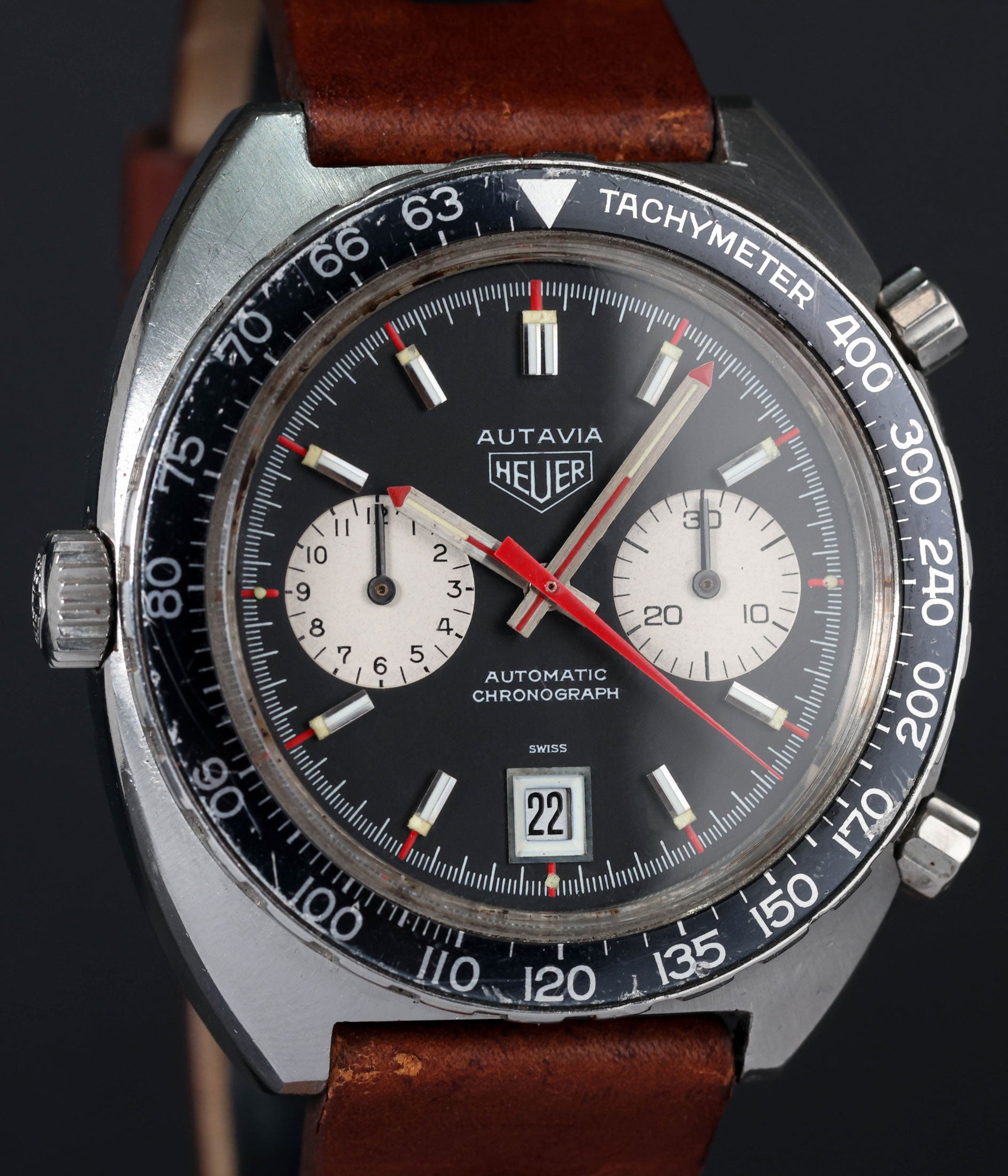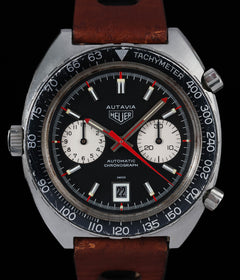Crown Vintage
Heuer Autavia 1163V Viceroy 42MM 1970s
Heuer Autavia 1163V Viceroy 42MM 1970s
Couldn't load pickup availability
Heuer Autavia 1163V Viceroy
The stainless‑steel case retains its original lines and crisp bevels, with only light hairline marks around the flanks and case‐back commensurate with careful wear; there are no dings, deep scratches or evidence of over‑polishing, so factory brushing and mirror transitions remain intact. Crown and pushers seat flush and function smoothly, while the lugs remain full with sharp lug‑hole edges. The aftermarket leather strap is in good condition. Under sapphire, the dial shows deep, even colour with all printing sharp; luminous hour markers have matured to a warm, even tone that matches the handset, and the hands themselves are clean with no corrosion or paint loss. Crystal is clear with only microscopic hairlines visible at certain angles, and bezel insert is free from major chips or fading. Overall, the watch presents as an honest, well‑looked‑after vintage piece requiring no immediate cosmetic attention.
Share
Why we love this watch
Why we love this watch
Heuer Autavia 1163V “Viceroy”: the chronograph that drove mainstream racing style
When Jack Heuer unveiled the first automatic Autavia in 1969, the watchmaking world took notice. The reference 1163, powered by the ground‑breaking Calibre 11 micro‑rotor movement, defined the modern sports chronograph: bold compression‑case architecture, integrated push‑pieces at two and four, and a signature left‑side crown that instantly flagged it as automatic. Three years later, the Autavia 1163V—nicknamed the “Viceroy” after a cigarette promotion—took that technical recipe and propelled it into living rooms across the United States, making the once‑exclusive chronograph suddenly attainable to a new audience of motorsport fans. The story of the 1163V is therefore equal parts engineering accomplishment, savvy marketing and cultural inflection point, and it remains one of the most significant references in the Heuer back‑catalogue.
A brief recap of the Autavia line
The Autavia name—an elision of “AUTomobile” and “AVIAtion”—first appeared on dashboard timers in the 1930s, then resurfaced in 1962 on Heuer’s dedicated racing wrist chronograph. Early manual‑wind Autavias earned fame on the wrists of drivers such as Jochen Rindt and Mario Andretti, but by the late 1960s Jack Heuer wanted an automatic calibre to stay ahead of Zenith and Seiko. Project 99, the consortium with Breitling, Hamilton‑Büren and Dubois Dépraz, delivered the Calibre 11 in March 1969. Heuer housed that movement in a new cushion‑shaped 42 mm case with squared lugs and an internal modular construction that could handle hard trackland knocks—an ideal platform for pit‑lane timing.
The genesis of the Viceroy promotion
By 1972 Heuer was enjoying brisk professional sales but still lacked broad consumer exposure in the United States. Brown & Williamson, owners of the Viceroy cigarette brand, approached the company for a nationwide promotion: collect Viceroy carton flaps, send them in with US $88, and receive an Autavia chronograph retailing for roughly triple that price. Heuer agreed on condition that the watch remain a normal catalogue model so as not to cheapen the brand. It became reference 1163V—V for Viceroy—distinguished by a black dial with contrasting white registers, red highlights on the central chronograph seconds and sub‑dial hands, and a black aluminium tachymetre bezel. Marketing collateral featured two‑time Indy 500 winner Al Unser, already a Heuer ambassador, wearing the watch amid plume trails of Championship Car racing.
Contemporary estimates suggest Heuer supplied at least 10,000 pieces for the promotion over a roughly eighteen‑month window—an unprecedented production run for a mechanical chronograph at the time. The exercise simultaneously strengthened Heuer’s racing credentials and introduced thousands of new enthusiasts to the brand, many of whom became lifelong collectors.
Design language and wrist presence
While the case shares its geometry with other third‑series Autavias, subtle cues set the 1163V apart. The brushed steel surfaces on the broad top‑plate flow cleanly into polished chamfers that catch ambient light, an effect amplified by the thin ridged bezel edge. The dial layout is pure purpose: white sub‑dials at three and nine for elapsed minutes and chronograph hours, constant seconds at six, and white applied hour markers filled with tritium that has now aged to warm almond. Red strips on the minute and hour hands, plus a red lollipop counterbalance on the chrono seconds, provide instant visual hierarchy for split‑second reads from the cockpit.
At 42 mm diameter and roughly 47 mm lug‑to‑lug, the 1163V wears smaller than modern figures suggest because the cushion case hugs the wrist, while a 20 mm lug width keeps strap changes straightforward. Period bracelets included the H‑link steel design by Gay Frères or a racer‑perforated Corfam strap, but collectors today often pair the watch with rally leather for extra period flair.
Calibre 11, later Calibre 12: pioneering automatic timing
The heart of the 1163V is the modular Calibre 11, a chronograph layer by Dubois Dépraz mounted piggy‑back onto a Büren base with an eccentric micro‑rotor that winds in both directions. Early customer feedback noted sluggish balance amplitude, leading Heuer to release the uprated Calibre 12 mid‑1972 with a higher beat rate of 21 600 vph (up from 19 800 vph) and a reinforced mainspring barrel that improved reliability. Most Viceroys encountered today house the Calibre 12, though transitional pieces exist. The movement’s left‑hand crown remains its most recognisable quirk—a conversation starter that invites the uninitiated to ask why the controls appear “backwards.”
Even by current standards the calibre offers robust performance: column‑wheel control ensures crisp pusher feel, the bi‑directional microrotor delivers efficient winding despite track vibrations, and the clutch architecture lets the chronograph run continuously without undue wear. Serviced properly, amplitude hovers comfortably above 260 degrees, demonstrating the foresight built into the original design.
Motorsport credentials and track‑side life
Heuer’s alliance with Formula 1 teams—most famously Ferrari from 1971—gave the Autavia unrivalled paddock exposure. Drivers such as Clay Regazzoni and Jacky Ickx could be seen timing practice laps with 1163 variants, while Al Unser’s Indy victories in 1970 and 1971 cemented the watch’s Stateside credibility. For amateur racers, the Viceroy promotion offered a direct link to professional kit: a genuine automatic chronograph priced within reach of weekend budgets. Period advertisements underscored that democratic appeal, pairing Unser’s winning car with the bold tagline “Same watch, same man, same victory.”
Commercial impact and market reception
Heuer’s bet paid off. Viceroy redemptions surged, driving brand recognition far beyond specialist jewellers. Dealer feedback at the time suggested increased Autavia sales even at full list price, as customers drawn by the promotion discovered other finishes such as the MH bezel or orange “Orange Boy” dial. Financially, Brown & Williamson subsidised part of the discount, while Heuer achieved economies of scale in case and dial manufacturing. The collaboration thus broadened margins rather than cannibalising them—a rare win‑win in luxury marketing.
The flip side was perceived exclusivity: traditionalists worried that widespread availability might dilute prestige. Yet history suggests the opposite; the 1163V became the gateway drug to serious Heuer collecting, fuelling long‑term demand for earlier manual‑wind Autavias and sister models like the Carrera 1153.
Legacy in contemporary collecting
Because production numbers were relatively high, the 1163V long remained the affordable entry point into vintage Heuer. Examples traded for modest sums well into the 2000s, often overlooked next to rarer Siffert and Jo Schenken colourways. That picture changed as appreciation grew for watches with authentic motorsport backstories. Original, unpolished Viceroys with correct dials, red seconds hands and intact tachymetre bezels now command solid five‑figure results at auction, with full‑set pieces fetching even stronger prices.
Collectors prize the model for three reasons. First, it offers the purest expression of first‑generation automatic chronograph engineering. Second, its Viceroy provenance is documented and specific, linking watchmaking to a decisive moment in American advertising. Third, the design’s red‑on‑black palette anticipates modern sports chronograph aesthetics, making the watch appear contemporary even after more than half a century.
Influence on the broader watch industry
The 1163V was an early proof that strategic partnerships could democratise high‑end horology without eroding cachet, a concept later seen in Swatch’s Omega MoonSwatch and F.P. Journe’s Holland & Holland collaboration. By offering genuine tool‑grade hardware at a reduced price, Heuer demonstrated that volume and desirability can coexist when marketing, design and authentic storytelling align. The ripple effect helped cement the automatic chronograph as mainstream kit, accelerating adoption across brands and consumer demographics.
Surviving examples and collecting pitfalls
Most surviving Viceroys show honest wear: faded bezels, tritium plots turned pale yellow or pumpkin, and brushed case flanks softened by polishing wheels. The dial varnish was robust, so spidering is rare, but moisture can leave dark halos at hand pivots. Replacement red chronograph seconds hands are common; thickness and tail length should be checked against period catalogues. Service crowns, lacking the “Heuer” shield relief, slightly diminish originality. Movement parts availability remains good thanks to Calibre 11/12 donor stocks, yet specialised know‑how is essential because the modular assembly requires disassembly in distinct layers, and incorrect mainspring choice can sap amplitude.
Final thoughts…
The Heuer Autavia 1163V “Viceroy” encapsulates the early 1970s intersection of competitive racing, pioneering micro‑rotor engineering and disruptive marketing. By teaming with Viceroy cigarettes, Heuer placed a technologically advanced chronograph on thousands of wrists at an accessible price, embedding the Autavia’s distinctive silhouette and left‑hand crown in popular consciousness. Half a century later the watch endures not merely as a collector curio but as a conduit to a formative chapter in sporting and commercial history. In the broader Heuer narrative it represents the moment the brand stepped beyond pit‑lane exclusivity and into everyday life—without sacrificing its identity. That blend of heritage, innovation and cultural relevance continues to drive its appeal among enthusiasts who value both provenance and wearability.
Case & Bracelet
Case & Bracelet
- Case in great vintage condition, hairlines visible around both sides of the case.
- Case remains sharp
- Aftermarket strap in good condition
Dial & Hands
Dial & Hands
Dial & hands in great condition.
Warranty & Condition
Warranty & Condition
Crown Vintage Watches provides a minimum 3-month mechanical warranty on pre-owned watches, from the date of purchase.
The warranty covers mechanical defects only.
The warranty does not cover damages such as scratches, finish, crystals, glass, straps (leather, fabric or rubber damage due to wear and tear), damage resulting from wear under conditions exceeding the watch manufacturer’s water resistance limitations, and damage due to physical and or accidental abuse.
Please note, water resistance is neither tested nor guaranteed.
Shipping and insurance costs for warranty returns to us must be covered by the customer. Returns must be shipped via traceable courier. Return shipment must be pre-paid and fully insured. Collect shipping will be refused. In case of loss or damages, the customer is liable.
Our Pledge
At Crown Vintage Watches, we stand by the authenticity of every product we sell. For added peace of mind, customers are welcome to have items independently authenticated at their own expense.
Condition
Due to the nature of vintage timepieces, all watches are sold as is. We will accurately describe the current condition and working order of all watches we sell to the best of our ability.
Shipping & Refund
Shipping & Refund
